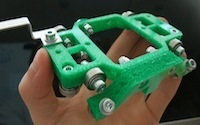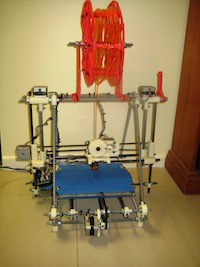Arthur C. Clarke said "Any sufficiently advanced technology is indistinguishable from magic." And it's still magical when you understand how it works. 3D printers are here, they're cool, and there is a large and enthusiastic open source 3D printer movement.
Like We Need More Plastic Doodads?
So what are these things for? Changing the world, literally, by disrupting manufacturing and distribution, and bringing the means of production of essential goods into everyone's hands.
3D printers produce physical objects from a computer file with a few mouse clicks. A cursory look at this technology might make it appear to be little more than yet another way to squeeze out more cheap plastic junk. But it is much more than cheap plastic junk; it's an amazingly fast way to prototype new products, and to customize small runs. Making customizations and small runs economical is going to be hugely disruptive because we won't have to produce runs of thousands to get the unit costs down, or charge giant markups for customizations. If anything it should reduce the tides of cheap plastic junk.
Industrial 3D printers have been around for about 30 years. The new wrinkle is bringing them into the reach of hobbyists and home users. The PBS show "This Old House" featured a high-end 3D Systems ZPrinter, which you can see for yourself in the Bedford: And the Work Begins episode.
Start watching at Chapter 3, Building a 3-D Printer Model. The homeowner works for 3D Systems and makes the architectural models for the project. He also demonstrates an intricate nest-of-gears mechanism that comes out of the printer fully functional, and some other intricate and colorful creations. The open source and lower-end printers can't do this, but then they don't cost upwards of $20,000 either.
3D printers do two things: make prototypes, and also finished products. In the olden days prototyping was a lot of labor-intensive skilled hand work that involved machining, models made from clay, wood, styrofoam, and other materials, welding, injection molding (very expensive, $10,000 and up per item), whatever it took to bring a concept to life. Any changes meant a lot more work, so experimentation was slow and expensive. With 3D printers all you do is change a few lines of code. Maybe someday, instead of making little architectural models, a giant unit will drive up to a building site and spit out a complete structure.
3D Scanners
3D scanners go hand-in-hand with 3D printers, and as far as I know there are no open source 3D scanners, or scanners that use open software, so this is an important missing piece. A 3D scanner digitizes physical objects and creates an editable computer file. Obviously, it is faster to start with a copy than to start a design from scratch. Obvious copyright issues aside, this has all kinds of wonderful practical uses like creating non-destructive copies of fossils and bones and valuable old artifacts and artworks, and creating replacement parts for machines and devices.
There are several different 3D scanner technologies. A contact scanner runs an articulated arm over an object. These are slow, and risk damaging fragile objects. Non-contact scanners are faster and non-destructive. 3D laser scanners are popular and come in all sizes and form factors, stationary and portable, and some can detect colors. These are expensive, in the thousands of dollars, and rely on expensive proprietary software. There are a number of open source 3D scanner projects that tell you how to build your own using inexpensive laser pointers.
Printing Materials
The term "printing" is a little misleading, at least for me, because it is firmly lodged in my brain as printing text and images on flat paper-like stuff. But this isn't totally off-the-wall because most 3D printers build objects a layer at a time, and you can see the edges of the layers in the finished item. An inkjet printing system lays down resin and binder layers, and prints in multiple colors. Other systems use gels, metals, waxes, liquid polymers, and plasters. There are even candy printers that create fancy edible goodies from sugar. The open source printers we're going to look at spin out a melted plastic filament that comes off spools, which gives the finished item a woven appearance (figure 1).

Figure 1: A green thingy printed by a RepRap printer. Image courtesy watdesign, Wikimedia Commons.
Open Source 3D Printers
Open source 3D printing is still in the hacker realm. There are no prefab personal open source 3D Printers; you have to build from kits or from scratch. Both are great exercises in learning how these work from the ground up. The open source 3D printers won't turn out completely-finished complex products like the ZPrinter. The simplest ones print one part at a time, and then you have to click the command to print another part, and then when you have all the parts you have to assemble them. There are higher-end printers that will print batch jobs. If you want color you can either use colored filaments, or paint the finished pieces.

Figure 2: RepRap Prusa 3D printer. Image courtesy JulianH72 and Wikimedia Commons.
The RepRap (replicating rapid prototyper) project has the ambitious goal of creating a self-replicating 3D printer. The plans and specs are free, and once you have one it can print the parts to create another one. It's not quite 100% self-replicating yet as it can print about half the needed parts, and you have to acquire the rest from other sources. Visit Makergear.com for a complete kit for a RepRap Prusa 3D Printer, which sells for about $900. The Prusa is called the Model T of RepRaps because it is fairly simple and sturdy. Makerbot sells parts and spools of filament in different colors.
The Makerbot Store carries a bigger inventory of all kinds of do-it-yourself electronic projects. The Thing-O-Matic kit builds a nice 3D printer that does batch jobs, so you can program it to print a whole bunch of parts and then go away and let it do its thing. This costs about $1100. The Makerbot Replicator prints larger objects, up to the size of a loaf of bread, and if you add a second extruder you can do two-color printing. With a second extruder it's about $2,000.
RepRap Central is another store that sells kits, parts, and supplies.
Software and Designs
How do you control these beasts? The most commonly-used software is ReplicatorG. Where do you get the digital models? Create your own with your favorite CAD software, or download from the many shared repositories like Thingiverse and Google 3D Warehouse.
To learn more visit the sites referenced in this article, and spend some quality time with Make Magazine, which has a lot of coverage of 3D printers.


No comments:
Post a Comment